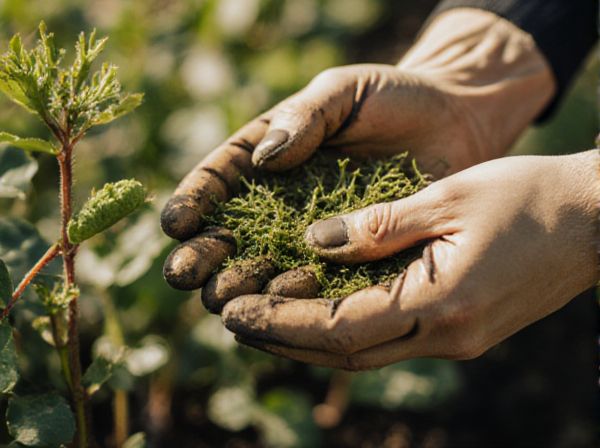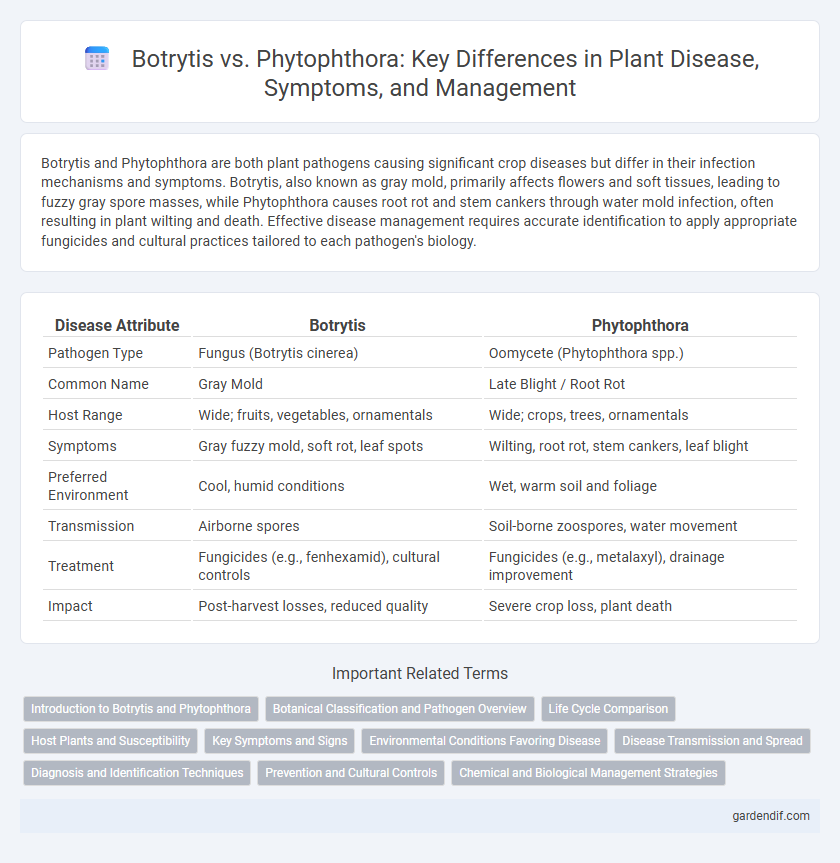
Botrytis vs Phytophthora Illustration
Botrytis and Phytophthora are both plant pathogens causing significant crop diseases but differ in their infection mechanisms and symptoms. Botrytis, also known as gray mold, primarily affects flowers and soft tissues, leading to fuzzy gray spore masses, while Phytophthora causes root rot and stem cankers through water mold infection, often resulting in plant wilting and death. Effective disease management requires accurate identification to apply appropriate fungicides and cultural practices tailored to each pathogen's biology.
Table of Comparison
| Disease Attribute | Botrytis | Phytophthora |
|---|---|---|
| Pathogen Type | Fungus (Botrytis cinerea) | Oomycete (Phytophthora spp.) |
| Common Name | Gray Mold | Late Blight / Root Rot |
| Host Range | Wide; fruits, vegetables, ornamentals | Wide; crops, trees, ornamentals |
| Symptoms | Gray fuzzy mold, soft rot, leaf spots | Wilting, root rot, stem cankers, leaf blight |
| Preferred Environment | Cool, humid conditions | Wet, warm soil and foliage |
| Transmission | Airborne spores | Soil-borne zoospores, water movement |
| Treatment | Fungicides (e.g., fenhexamid), cultural controls | Fungicides (e.g., metalaxyl), drainage improvement |
| Impact | Post-harvest losses, reduced quality | Severe crop loss, plant death |
Introduction to Botrytis and Phytophthora
Botrytis and Phytophthora are significant plant pathogens that cause widespread agricultural damage. Botrytis, commonly known as gray mold, primarily affects flowers, fruits, and vegetables by thriving in humid environments and causing tissue decay. Phytophthora, a genus of oomycetes, targets roots and stems, leading to root rot and blight in a variety of crops, often triggered by waterlogged soil conditions.
Botanical Classification and Pathogen Overview
Botrytis and Phytophthora are distinct pathogens with differing botanical classifications; Botrytis belongs to the kingdom Fungi, specifically the phylum Ascomycota, while Phytophthora is an oomycete classified under the kingdom Stramenopila. Botrytis cinerea, commonly known as gray mold, primarily infects aerial plant parts causing necrosis and decay, whereas Phytophthora species, such as Phytophthora infestans, cause devastating root and stem rots by producing motile zoospores that thrive in moist conditions. The divergent life cycles and reproductive structures between these two pathogens influence their infection strategies and host range across agricultural and horticultural crops.
Life Cycle Comparison
Botrytis cinerea, a necrotrophic fungus, thrives in cool, humid conditions and produces conidia that germinate to infect plant tissues rapidly, often overwintering as sclerotia or mycelium on plant debris. In contrast, Phytophthora species are oomycetes with a lifecycle involving both asexual sporangia which release zoospores and sexual oospores that survive adverse conditions, enabling infection in wet environments through motile spores. Botrytis primarily infects above-ground plant parts through surface wounds, while Phytophthora targets roots and basal stems, making their life cycles and infection strategies distinctly adapted to their ecological niches.
Host Plants and Susceptibility
Botrytis primarily affects a wide range of host plants including strawberries, grapes, and tomatoes, where it causes gray mold, especially under high humidity and moderate temperatures. Phytophthora targets a diverse group of plants such as potatoes, soybeans, and avocados, inducing root rot and crown rot under wet, poorly drained soil conditions. Host susceptibility varies with environmental factors and plant species, with Botrytis favoring soft fruits and flowers, while Phytophthora primarily attacks roots and lower stems of woody and herbaceous plants.
Key Symptoms and Signs
Botrytis, also known as gray mold, primarily causes fuzzy gray spores on plant surfaces, wilting, and brown lesions with water-soaked edges. Phytophthora, a soil-borne pathogen, leads to root rot, stem cankers, and dark, sunken lesions often accompanied by a distinct foul odor. Both diseases exhibit rapid tissue decay, but Botrytis prefers cool, humid conditions while Phytophthora thrives in overly wet, poorly drained soils.
Environmental Conditions Favoring Disease
Botrytis thrives in cool, humid environments with poor air circulation, typically between 59-68degF (15-20degC), where moisture on plant surfaces promotes fungal growth. Phytophthora favors warm, water-saturated soils above 68degF (20degC), often following heavy rainfall or poor drainage, leading to root rot and crown disease. Managing environmental factors such as humidity, temperature, and soil moisture is critical to preventing the spread of both pathogens.
Disease Transmission and Spread
Botrytis cinerea primarily spreads through airborne spores that infect plant tissues via wounds or natural openings, thriving in humid environments. In contrast, Phytophthora species, responsible for water molds, transmit mainly through soil and water movement, infecting roots and lower stems in saturated soils. Effective management requires understanding Botrytis' aerial dispersal versus Phytophthora's soil-borne and water-mediated transmission pathways for targeted disease control.
Diagnosis and Identification Techniques
Botrytis and Phytophthora diseases can be distinguished through molecular diagnostic techniques such as PCR assays targeting specific pathogen DNA sequences, enabling precise identification at the species level. Traditional microscopy reveals Botrytis cinerea's characteristic conidia and mycelium, while Phytophthora species exhibit distinctive zoospores and sporangia in wet mount preparations. Advanced immunoassays and ELISA tests provide rapid, sensitive detection, further aiding in differentiating these pathogens in plant tissue samples.
Prevention and Cultural Controls
Botrytis cinerea prevention relies on maintaining low humidity and good air circulation to reduce fungal spore development, while removing infected plant debris limits inoculum sources. Phytophthora management emphasizes well-drained soils and avoiding overwatering to prevent root and crown rot, along with using resistant plant varieties for cultural control. Crop rotation and sanitation practices are critical for both pathogens to minimize disease incidence and spread.
Chemical and Biological Management Strategies
Botrytis cinerea management relies heavily on chemical fungicides such as boscalid and fenhexamid, complemented by biological agents like Bacillus subtilis and Trichoderma harzianum to suppress fungal growth. Phytophthora species are effectively controlled using phosphonate-based chemicals and metalaxyl, with biocontrol options including Pseudomonas fluorescens and mycorrhizal fungi enhancing plant resistance. Integrated disease management combines these treatments to reduce pathogen resistance and promote sustainable crop protection.
Botrytis vs Phytophthora Infographic

 gardendif.com
gardendif.com